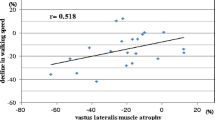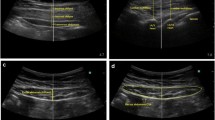Abstract
This study investigated the effects of age and inactivity due to being chronically bedridden on atrophy of trunk muscles. The subjects comprised 33 young women (young group) and 41 elderly women who resided in nursing homes or chronic care institutions. The elderly subjects were divided into two groups: independent elderly group who were able to perform activities of daily living involving walking independently (n = 28) and dependent elderly group who were chronically bedridden (n = 13). The thickness of the following six trunk muscles was measured by B-mode ultrasound: the rectus abdominis, external oblique, internal oblique, transversus abdominis, thoracic erector spinae (longissimus) and lumbar multifidus muscles. All muscles except for the transversus abdominis and lumbar multifidus muscles were significantly thinner in the independent elderly group compared with those in the young group. The thicknesses of all muscles in the dependent elderly group was significantly smaller than that in the young group, whereas there were no differences between the dependent elderly and independent elderly groups in the muscle thicknesses of the rectus abdominis and internal oblique muscles. In conclusion, our results suggest that: (1) age-related atrophy compared with young women was less in the deep antigravity trunk muscles than the superficial muscles in the independent elderly women; (2) atrophy associated with chronic bed rest was more marked in the antigravity muscles, such as the back and transversus abdominis.

Similar content being viewed by others
References
Ainscough-Potts AM, Morrissey MC, Critchley D (2006) The response of the transverse abdominis and internal oblique muscles to different postures. Man Ther 11:54–60
Bemben MG, Massey BH, Bemben DA, Misner JE, Boileau RA (1991) Isometric force production as a function of age in healthy 20- to 74-yr-old men. Med. Sci. Sports Exerc 23:1302–1310
Bergmark A (1989) Stability of the lumbar spine: a study in mechanical engineering. Acta Orthop Scand Suppl 60:1–54
Bogduk N, Macintosh JE, Pearcy MJ (1992) A universal model of the lumbar back muscles in the upright position. Spine 17:897–913
Brooks SV, Faulkner JA (1994) Skeletal muscle weakness in old age: underlying mechanisms. Med Sci Sports Exerc 26:432–439
Cholewicki J, Panjabi MM, Khachatryan A (1997) Stabilizing function of trunk flexor-extensor muscles around a neutral spine posture. Spine 22:2207–2212
De Troyer A, Estenne M, Ninane V, Van Gansbeke D, Gorini M (1990) Transversus abdominis muscle function in humans. J Appl Physiol 68:1010–1016
Doherty TJ, Vandervoort AA, Brown WF (1993) Effects of ageing on the motor unit: a brief review. Can J Appl Physiol 18:331–358
Dupont AC, Sauerbrei EE, Fenton PV, Shragge PC, Loeb GE, Richmond FJ (2001) Real-time sonography to estimate muscle thickness: comparison with MRI and CT. J Clin Ultrasound 29:230–236
Fujiwara K, Asai H, Toyama H, Kunita K, Yaguchi C, Kiyota N, Tomita H, Jacobs JV (2010) Changes in muscle thickness of gastrocnemius and soleus associated with age and sex. Aging Clin Exp Res 22:24–30
Fukunaga T, Miyatani M, Tachi M, Kouzaki M, Kawakami Y, Kanehisa H (2001) Muscle volume is a major determinant of joint torque in humans. Acta Physiol Scand 172:249–255
Hebert JJ, Koppenhaver SL, Parent EC, Fritz JM (2009) A systematic review of the reliability of rehabilitative ultrasound imaging for the quantitative assessment of the abdominal and lumbar trunk muscles. Spine 34:E848–E856
Hides JA, Belavý DL, Stanton W, Wilson SJ, Rittweger J, Felsenberg D, Richardson CA (2007) Magnetic resonance imaging assessment of trunk muscles during prolonged bed rest. Spine 32:1687–1692
Hodges PW (1999) Is there a role for transversus abdominis in lumbo-pelvic stability? Man Ther 4:74–86
Ikezoe T, Mori N, Nakamura M, Ichihashi N (2010a) Age-related muscle atrophy in the lower extremities and daily physical activity in elderly women. Arch Gerontol Geriatr (Epub ahead of print)
Ikezoe T, Mori N, Nakamura M, Ichihashi N (2010b) Atrophy of the lower limbs in elderly women: is it related to walking ability? Eur J Appl Physiol (Epub ahead of print)
Janssen I, Heymsfield SB, Wang Z, Ross R (2000) Skeletal muscle mass and distribution in 468 men and women aged 18–88 yr. J Appl Physiol 89:81–88
Johnson MA, Polgar J, Weightman D, Appleton D (1973) Data on the distribution of fibre types in thirty-six human muscles. An autopsy study. J Neurol Sci 18:111–129
Joseph J, McColl I (1961) Electromyography of muscles of posture: posterior vertebral muscles in males. J Physiol 157:33–37
Kanehisa H, Miyatani M, Azuma K, Kuno S, Fukunaga T (2004) Influences of age and sex on abdominal muscle and subcutaneous fat thickness. Eur J Appl Physiol 91:534–537
Kiefer A, Shirazi-Adl A, Parnianpour M (1997) Stability of the human spine in neutral postures. Eur Spine J 6:45–53
Koppenhaver SL, Hebert JJ, Fritz JM, Parent EC, Teyhen DS, Magel JS (2009) Reliability of rehabilitative ultrasound imaging of the transversus abdominis and lumbar multifidus muscles. Arch Phys Med Rehabil 90:87–94
Kubo K, Kanehisa H, Azuma K, Ishizu M, Kuno SY, Okada M, Fukunaga T (2003) Muscle architectural characteristics in women aged 20–79 years. Med Sci Sports Exerc 35:39–44
Lexell J, Taylor CC, Sjostrom M (1988) What is the cause of the ageing atrophy? Total number, size and proportion of different fiber types studied in whole vastus lateralis muscle from 15- to 83-year-old men. J Neurol Sci 84:275–294
Mannion AF (1999) Fibre type characteristics and function of the human paraspinal muscles: normal values and changes in association with low-back pain. J Electromyogr Kinesiol 9:363–377
Misuri G, Colagrande S, Gorini M, Iandelli I, Mancini M, Duranti R, Scano G (1997) In vivo ultrasound assessment of respiratory function of abdominal muscles in normal subjects. Eur Respir J 10:2861–2867
Miyatani M, Kanehisa H, Ito M, Kawakami Y, Fukunaga T (2004) The accuracy of volume estimates using ultrasound muscle thickness measurements in different muscle groups. Eur J Appl Physiol 91:264–272
Park H, Park S, Shephard RJ, Aoyagi Y (2010) Yearlong physical activity and sarcopenia in older adults: the Nakanojo Study. Eur J Appl Physiol 25 (Epub ahead of print)
Rankin G, Stokes M, Newham DJ (2006) Abdominal muscle size and symmetry in normal subjects. Muscle Nerve 34:320–326
Rantanen J, Rissanen A, Kalimo H (1994) Lumbar muscle fiber size and fiber type distribution in normal subjects. Eur Spine J 3:331–335
Roos MR, Rice CL, Vandervoort AA (1997) Age-related changes in motor unit function. Muscle Nerve 20:679–690
Sanada K, Kearns C, Midorikawa T, Abe T (2006) Prediction and validation of total and regional skeletal muscle mass by ultrasound in japanese adults. Eur J Appl Physiol 96:24–31
Stokes M, Rankin G, Newham DJ (2005) Ultrasound imaging of lumbar multifidus muscle: normal reference ranges for measurements and practical guidance on the technique. Man Ther 10:116–126
Stokes M, Hides J, Elliott J, Kiesel K, Hodges P (2007) Rehabilitative ultrasound imaging of the posterior paraspinal muscles. J Orthop Sports Phys Ther 37:581–595
Teyhen DS, Gill NW, Whittaker JL, Henry SM, Hides JA, Hodges P (2007) Rehabilitative ultrasound imaging of the abdominal muscles. J Orthop Sports Phys Ther 37:450–466
Wallwork TL, Hides JA, Stanton WR (2007) Intrarater and interrater reliability of assessment of lumbar multifidus muscle thickness using rehabilitative ultrasound imaging. J Orthop Sports Phys Ther 37:608–612
Yazawa A, Watanabe K, Yoshida Y, Imaki M, Tanada S (2007) Relationship between physical activity measured by accelerometer and muscle mass, physical fitness and blood test values in middle-aged and elderly people. J Anal Biosci 30:279–285
Conflict of interest
None.
Author information
Authors and Affiliations
Corresponding author
Additional information
Communicated by Arnold de Haan.
Rights and permissions
About this article
Cite this article
Ikezoe, T., Mori, N., Nakamura, M. et al. Effects of age and inactivity due to prolonged bed rest on atrophy of trunk muscles. Eur J Appl Physiol 112, 43–48 (2012). https://doi.org/10.1007/s00421-011-1952-x
Received:
Accepted:
Published:
Issue Date:
DOI: https://doi.org/10.1007/s00421-011-1952-x




